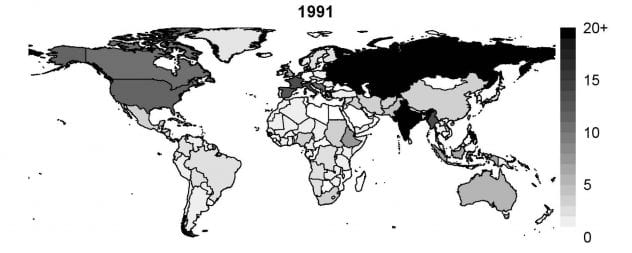Much of world history has been the history of secessionism. Much of that history has been violent. New nation-states often come from the violent dissolution of larger states or empires and violence has earned many nations the right to exist as sovereign entities. Indeed, most armed conflicts since the end of the Cold War have been about self-determination. A large literature in political science and economics has tried to identify the causes of secessionist conflicts and explain the genesis of self-determination movements. Yet there is no unifying theoretical framework that can explain which countries or which regions are more likely to experience conflict over self-determination or why some of those conflicts turn violent. PIC Lab addresses those important questions in a number of ways, starting with the collection and publication of new data on the incidence of separatist conflicts world-wide.
In a recently published paper, PIC Lab Director Nicholas Sambanis along with research collaborators Micha Germann and Andreas Schädel collected new data on all self-determination movements (SDM) around the world since 1945. The data are supported by extensive documentation and improve coverage relative to all previously available datasets. We can use these data to gauge the increased prevalence of SDMs over time, as is evident in the Figures below, showing the location of SDMs around the world in 1947, 1976, 1991, and 2012.
The new SDM dataset significantly expands coverage relative to any previously available database. This is clear in the figure below, which presents a simple comparison of cases in the new SDM dataset compared to two other widely used datasets. The number of self-determination (SD) conflicts in the CONIAS dataset produced by researchers at the University of Heidelberg is 156. Over the same period (1945-2005), the same number (156) of SD conflicts is also coded in a dataset produced by researchers at the University of Maryland (panel 2 in the figure below). By contrast, the SDM datasets includes 479 conflicts over the same period.
PIC Lab researchers use the new data to explore the causes of self-determination movements. In a recently published article in the Journal of Conflict Resolution, Nicholas Sambanis, Micha Germann, and Andreas Schädel use the new data to revisit an influential argument in the extant literature that governments will not accommodate groups seeking self-determination if they face several potential future challengers because they want to build a reputation for strength. Using the SDM data to replicate a major study on this question, the PIC Lab researchers do not find support for this reputational explanation for separatist conflict.
As is evident in the third panel of the figure above, most SDMs are non-violent. Yet most of what we know about conflicts over self-determination comes from analyses of violent cases, including separatist civil wars. In new research, PIC Lab Director Nicholas Sambanis and affiliated researcher Micha Germann use the new SDM dataset to explore the causes of escalation of self-determination movements. This study asks whether violent and nonviolent conflicts are qualitatively different from each other. Or are their causes different? Surprisingly, this question has not been tested using quantitative data previously. Using the new SDM data, they investigate the role of ethnic grievances in why nonviolent separatist conflicts emerge and why some of them subsequently escalate to violence. They find evidence that political exclusion and lost autonomy—two grievance factors commonly associated with ethnic war—are associated with the onset of nonviolent separatist claims, but both factors also help explain why nonviolent conflicts escalate to violence. Results from this new study support grievance-based explanations of ethnic war and highlight the need to focus on processes of conflict escalation to improve the specificity of models of civil war. This study is currently under review; you can read a draft here.
PIC Lab affiliates are currently working to expand the SDM dataset. Geo-coded data on the location of all 479 movements around the world will soon be posted on this website along with new research on self-determination and secession.




